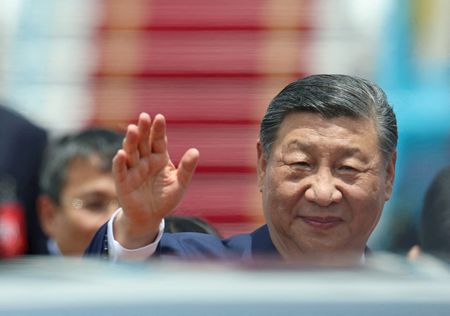By Mei Mei Chu and Ella Cao
BEIJING (Reuters) -China will plant four to five times more genetically modified (GM) corn this year than last, analysts and executives say, building momentum in a rollout that has been slowed by tight state controls, public scepticism, and mixed trial outcomes.
After decades of caution, the world’s top importer of corn and soybeans has in the past two years ramped up approvals of several GM seed varieties, touting biotech cultivation, or GM technology as a way to boost food security.
China’s GM corn planting area is on track to increase to between 40 million and 50 million mu (3.3 million hectares) this year from roughly 10 million mu in 2024, according to CITICS Research and three seed industry insiders, all of whom spoke on condition of anonymity due to the sensitivity of the matter in the country.
While not directly tied to the U.S.-Sino trade war, the push to grow more GM corn could reduce China’s need for imports, giving Beijing a new lever in its tariff battle with President Donald Trump. The U.S. last year supplied 15% of China’s corn imports.
Even with the increase in plantings, GM corn would still only account for 7% of China’s total corn acreage, compared with over 90% in agricultural heavyweights such as the United States or Brazil.
China could quickly reach similar levels by embracing GM technology, however Beijing has tended towards caution in the face of ingrained scepticism from consumers and farmers.
The government tightly manages seed sales and planting through controls that industry executives say make planning difficult and that have left domestic seed companies sitting on a glut of seeds.
“Market adoption hinges on two key factors: demonstrated yield and cost benefits for farmers, and Beijing’s ability to align commercial rollout with persistent public scepticism,” said Matthew Nicol, senior analyst at research group China Policy.
DISAPPOINTING TRIALS
China imports over 100 million metric tons of corn and soybeans each year, mostly GM varieties for animal feed, predominantly from Brazil and the U.S., while cultivating non-GM crops locally for food consumption.
Crops genetically modified for higher yields or resistance to drought and pests could boost yields by 6-13%, according to estimates from analysts and one seed official.
However, several recent GMO trials resulted in lower yields, disappointing some farmers already sceptical about the technology, according to the three sources familiar with the rollout, putting progress at risk.
Some regions where first-generation GM corn trials were planted during 2022-2023 saw 10-20% yield declines, the sources said.
The problems arose from seeds only partially suited to local conditions, or rushed to market without enough backcross breeding – where a hybrid plant is crossed with a parent plant to develop desired traits, the three industry sources said.
The results of those trials have not been made public.
China’s Ministry of Agriculture and Rural Affairs did not reply to a request for comment.
“If seed firms fail to improve agronomic performance yields, even in trial conditions, Beijing’s GM strategy could face a credibility issue, prolonging adoption timelines,” Nicol said.
Some farmers seeking higher yields, meanwhile, have turned to illegal GM seeds or conventional hybrid seeds, two of the sources said.
“The prevalence of illegal GM corn in the northeast, as reported by industry insiders … underscores the latent demand for advanced traits,” Nicol added.
The agriculture ministry this month called for provinces to crack down on illegal production and sale of GM seeds.
As GM seed planting moves from small pilot plots to large-scale planting, yields could initially fall as farmers cannot devote as much time to individual plants, said Even Rogers Pay, an agriculture analyst at Trivium China. It will take time to adapt to new varieties, she added.
“Regulators will hit the brakes on that plan if any significant issues arise,” Pay said.
“But assuming the new varieties continue to show an advantage over what was getting planted before, it’s fair to expect that acreage will continue to expand. The proverbial genie is not going back into the bottle.”
(Reporting by Ella Cao and Mei Mei Chu in Beijing; additional reporting by Gus Trompiz in Paris; Editing by Sonali Paul)











